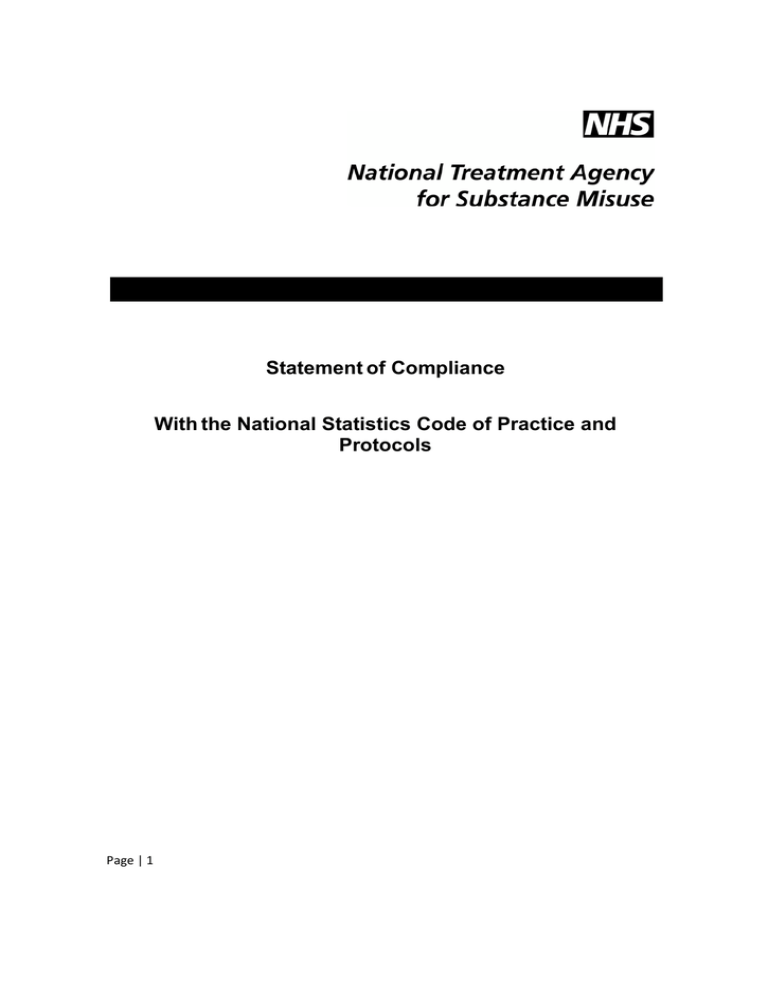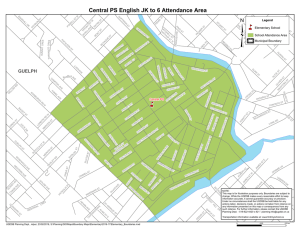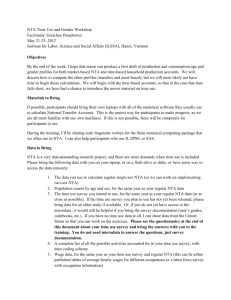Compliance Statement - National Treatment Agency for Substance
advertisement

National Drug Treatment Monitoring System (NDTMS) Statement of Compliance With the National Statistics Code of Practice and Protocols Page | 1 1. INTRODUCTION The National Treatment Agency (NTA) is a Special Health Authority established in 2001. The job of the NTA is to improve the availability, accessibility and effectiveness of treatment for drug dependency in England and to maximise the benefits of that treatment for individuals, their families and communities. The NTA reports to the Department of Health, and also work closely with the Home Office, the Department for Education, and the Ministry of Justice. The NTA is committed to providing a balanced treatment system, which can offer people the help that will most likely meet their individual needs, helping them recover from dependency, and reintegrate them back into society. The priorities of the NTA are to: • • • • • Help people overcome addiction and regain their lives Support their families to rebuild their lives Help build the evidence underpinning drug treatment Promote a balanced treatment system, where the type of treatment you get matches your needs Benefit communities through less crime, better health and more stable families Page | 2 2. COMPLIANCE WITH CODE OF PRACTICE AND PROTOCOLS The NTA is responsible for collecting, compiling, processing, analysing, interpreting, and disseminating statistics on drug treatment including numbers in treatment, numbers retained in treatment and the number discharged in any period. Some of the statistics produced are designated as ‘National Statistics’ which means that they are produced in accordance with the arrangements set out in the Framework for National Statistics and in line with the principles in the National Statistics Code of Practice and its supporting Protocols. Links to Framework, Code and Protocols: http://www.statistics.gov.uk/about_ns/downloads/FrameDoc1.pdf http://www.statistics.gov.uk/about/national_statistics/cop/downloads/StatementRD.pdf http://www.statistics.gov.uk/about/national_statistics/cop/protocols_published.asp There are currently 12 protocols in existence. A list of our ‘National Statistics’ data products is outlined in the Release Schedule at Annex B. A fuller version will appear on the website. As well as complying with the Code of Practice and its supporting Protocols, all of our National Statistics are also produced and published in accordance with the following statements and policies, each of which forms an integral part of this compliance statement. 3 - Statement of Customer Service and Complaints 4 - Publications Strategy 5 - Statement on Release Practices 6 - Statement on Revisions and Errors 7 - Statement on Confidentiality and Access 8 - Data Management Policy 9 - Statement of Quality Assurance Page | 3 3. STATEMENT ON CUSTOMER SERVICE AND COMPLAINTS In respect of specific engagement with statistics users and customers, this Statement is issued in accordance with the requirements set out in the Protocol on Customer Service and User Consultation. It describes our intention to provide a high level of service to all our customers. We aim to provide the following standards of service. Service to Data Suppliers We will endeavour to operate efficiently by placing the minimum load necessary on data providers. We will take good care of all the information provided to us and we will respect the confidentiality of all information which may identify an individual as outlined in the Statement of Confidentiality and Access. Service to Users We will, maintain the relevance of all our statistical activities so that they reflect the needs of our users, and where possible, make sure that the information we provide is equally accessible to the whole community. Producers of National Statistics will recognise the importance of engaging with the concerns of each customer and, in the case of significant users, the advantage of developing long-term relationships. We welcome constructive comments on everything we do because this will help us to improve our service. Service Standards If you get in touch with us, you can expect us to be polite, approachable and helpful, and to readily identify ourselves. We will make every reasonable effort to ensure that you are provided with information that is timely, relevant and accurate. Sometimes, our service delivery standards will be affected by circumstances beyond our control and occasionally we make mistakes. When this happens we will apologise and do everything we reasonably can to put things right. If you have concerns about the quality, or the treatment you have received from us and you cannot resolve the problem with the person you have been dealing with, you can make a formal complaint. Details of how to raise a formal complaint are available on the NTA website: http://www.nta.nhs.uk/FOI.aspx Page | 4 4. PUBLICATION STRATEGY Introduction Our Publication Strategy is issued in accordance with the requirements set out in the National Statistics Protocol on Data Presentation, Dissemination and Pricing. Its aim is to make our National statistics accessible to the widest possible community and to maximize the use of our statistical information in all walks of life – subject to the need to comply with legal, ethical and confidentiality constraints. It is based on the following key principles: • Knowing our customers – the content of our resources and products, and the supporting information we provide will be informed by an understanding of our customers’ needs • Informing our users – we will help customers and users to understand and make the best possible use of our products by publishing supporting, background, or educational information and material • A common identity – we will make it easier to identify which of our products have been branded as ‘National Statistics’ by using a common logo and by following standard practices and procedures. • Web focus – In order to promote widespread access and informed public debate, we will use the Web as our main channel for the dissemination of statistics. This means that our products will appear on NTA website with links on the National Statistics website, or linked Departmental websites. • Charging – All the information we publish on-line will be free at the point of use. Any charges we impose will conform to the rules and procedures set out in the Protocol. • Accessibility – We will make it easy for users to find and understand our published data by using adequate signposting and standard documentation procedures. • Exceptions – None Page | 5 5. STATEMENT ON RELEASE PRACTICE Application of protocol to National Statistics produced by the NTA Unless otherwise indicated below the Release Practice Protocol will apply in full. Due to tight deadlines, certain items outlined below may not be in place prior to publication; however, all will be implemented at the earliest opportunity. Accessibility: Number and types of releases The agency will issue a monthly report updated each month and an annual report which will be National Statistics releases from January 2006. The monthly data will be updated each month with the best quality information and will replace previous month’s information where necessary. The annual data will remain static. None of these statistical releases are regarded as market sensitive. The publication will be an internet release available for download free of charge. The Agency will make effective electronic access to data a high priority in accordance with government policy on electronic delivery of services. Pre-announcement Release dates for the outputs will be pre-announced in National Statistics Release Calendar. An established timetable for the preparation of the regular monthly report and the exact publication date will be given six months in advance. For quarterly and annual releases, the month of publication will be given with the exact date given at least two weeks in advance. A programme of releases will be maintained and regularly updated. Timing of Release Publication is announced by means of a Statistical Press Notice from the Communications Team, usually issued at 9:30 during a normal working day, together with national trade and regional policy press releases. The backup data in the form of excel tables will appear online. Format of Release The Chief Executive has responsibility for the contents and format of all statistical outputs in consultation with the Department of Health Statistical Head of Profession. The main release formats are: • • Bulletins (a number of tables and commentary) Short statistical releases (summary or headline figures which may be followed by a bulletin • Website tables (which may exclude commentary in order to focus on timely publication and in depth data) All publications are in standard format and contents will be continually reviewed to reflect changing needs of users and to allow proper presentation and analysis of any new or particularly interesting results. Page | 6 Pre-release access to statistics The information team within the agency will maintain a record available for public scrutiny of all those who have pre release access by job title. This will include those with access for management, briefing and/or quality assurance purposes. Normally and in line with the National Statistics Protocol on Release Practices, pre-release access for Ministerial briefing will be no more than five days ahead of publication. With the agreement of the DH Head of Profession and the Chief Executive of the NTA, for any National Statistics outputs which are particularly high profile or complex, earlier access may be given in order to allow ministers to fulfil their NHS responsibilities. Details of those allowed pre-release access for briefing will be published on the NTA website. The provisions relating to market sensitive data do not apply to the NTA as there are no such publications. A security marking “Restricted Statistics” as at Annex A below will be used when circulating documents that contain statistics intended for publication which are not already in the public domain. Availability of detailed results More detailed results will be made available on request subject to restrictions of confidentiality, data quality and cost. Details for individual releases A release schedule document will outline the details of individual releases and will be published online. As stated above details of all those who have pre-released access will be published on the NTA website. Updating procedure The NTA will endeavour to ensure that the notes on release arrangements and complementary information on the NTA and National Statistics websites are regularly updated. Page | 7 ANNEX A - HEADER ON ALL DOCUMENTS ‘RESTRICTED until publication on [date] at [time] - STATISTICS’ to appear on all pages as a header. Footer on all pages of word processing documents (e.g. MS Word or Adobe Acrobat pdf) and on 1st page of data documents (e.g. MS Excel) You are reminded that these are official statistics to which you have privileged access in advance of release. Such access is carefully controlled and is provided for management, quality assurance, and briefing purposes only. Release into the public domain or any public comment on these statistics prior to official publication would undermine the integrity of official statistics. Any accidental or wrongful release should be reported immediately and may lead to an inquiry. Wrongful release includes indications of the content, including descriptions such as "favourable" or "unfavourable". If in doubt you should consult Malcolm Roxborough who can advise. Please prevent inappropriate use by treating this information as restricted, refrain from passing information on to others who have not been given prior access and use it only for the purposes for which it has been provided. Footer to appear on 2nd and subsequent pages of data documents (e.g. MS Excel) [NB. Full explanation above is not suitable for all file formats.] You are reminded that these are official statistics to which you have privileged access in advance of release. Such access is carefully controlled and is provided for management, quality assurance, and briefing purposes only. Page | 8 6. STATEMENT ON REVISIONS AND ERRORS Revisions This statement is issued in accordance with the requirements set out in the Protocol on Revisions and sets out our intentions to be open and transparent about any revisions we make to National Statistics and to ensure that users of our statistics will have easy access to comprehensive information about those revisions: We will achieve this aim by: • Maintaining an area on the NTA website which provides access to: o a list of any of our key National Statistics which are subject to a scheduled pattern of revisions as well as a link (where appropriate) to their revisions policy o current and historical information on any revisions, corrections or changes to any of our National Statistics, and the reasons for their occurrence o explanations for and background details about, revisions, corrections or methodological changes within any publication that incorporates them o lists any of our key outputs which are deliberately not revised and the reasons why • Including explanations for and background details about, revisions, corrections or methodological changes within any of the publications that incorporate them. Errors Most revisions are a normal feature of statistical life. However some revisions are ‘avoidable’ in the sense that they are the consequence of errors or weaknesses in our procedures or systems, rather than of design. In the latter case, and, regardless of whether the responsibility is ours or others, we will follow the procedures described below: Announcement of impending corrections We will be open and transparent about the need for any unscheduled corrections and in normal circumstances, and once we ascertain the need for a correction and become aware of its likely size and direction, we will inform about our intention to issue corrections and by when. Page | 9 Dissemination of corrections Decisions relating to the dissemination of unscheduled corrections will be made by Head of Information in the light of the circumstances prevailing at the time but in general terms: Web versions of releases/publications/tables/articles/etc • As soon as possible after we ascertain that a correction is necessary and warranted, we will amend all current electronic versions of any release, publication, table, article, etc which contains the affected statistics or text and repopulate the website as soon as possible • Decisions about whether corrections are warranted will take into account potential disruption to customers and potential impact on customer confidence and will take into account the proper use of resources. Therefore some minor errors will be corrected, while others will not, while all major errors will be corrected • If the correction is minor, we will insert the necessary changes without alerting anyone in advance but will indicate on the web that this has occurred and the reason why. If the error is major, we will, in addition, issue a prominent alert on the website to notify users about the correction and the reasons for its occurrence. Page | 10 7. CONFIDENTIALITY AND ACCESS The emphasis of the principles listed in protocol on Data access and Confidentiality is on the protection of the individual and the fact that any information is published at a high level means that the individual are in the main protected. A number of security items are in place within the NTA systems to prevent unauthorised access including password protection. Clients are informed that their data will be used for collection of Statistics and are advised that they will not be identifiable by the statistics and are to sign a form giving informed consent. They have a right to refuse. Data is published at agency level and a discussion is underway about suppression of data within the NTA and with the National Drug Evidence Centre (NDEC) at Manchester University. Work is also currently underway at the Office of National Statistics on providing guidance on this issue. Until such time as guidance is available, it has been agreed that a level of 5 should be set for suppression and this will implemented within the relevant systems. This will be reviewed on a regular basis to ensure that the quality of information provided is not affected. The only Personal level information which is given out is that of an individual client if the client themselves asks for information as we have a legal obligation to handle their request under the Data Protection and Freedom of Information Acts. We would request their name and details and record this information. Data Matching is carried out by the NTA as part of the production of Statistics to obtain attendance and retention information. This is the equivalent of Exact Matching. The NTA complies with the Protocol on Data Matching by obtain permission from the respondents as a matter of routine. The data are used purely for statistical purposes to build monthly and annual reports on performance and treatment and for related research. All data is merged to avoid disclosure and the measures for which the data is being matched are specific and only the minimum number of items are used. Page | 11 8. DATA MANAGEMENT POLICY Introduction Our Data Management Policy is published in accordance with the requirements set out in the National Statistics Protocol on Data Management, Documentation and Preservation. http://www.statistics.gov.uk/about/national_statistics/cop/protocols_published.asp It applies to all our National Statistics, whether obtained from administrative or statistical sources, and howsoever published. The policy also applies to any associated metadata or documentation. Principles of Information Management The NTA’s main principles of information management are: 1. Information is a corporate resource. It does not belong to any individual or group. Unless specified when collected, information collected for statistical purposes is only used for statistical purposes. 2. Everybody is responsible for the effective management of the information they create or use. 4. We will make information accessible to others in NTA, except where there are specific reasons not to. 5. We will adopt a consistent approach to managing information across the NTA. 6. We will share information across the agencies, regional offices and others involved with the NTA, except where there is a specific reason not to. 7. We will retain details of all the business activities we undertake on behalf of the NTA. 8. We will ensure that the information we create is accurate and fit for purpose. 9. In managing our information we will comply with the relevant statutory and regulatory requirements. Page | 12 Implementing Data Management Responsibility for the day-to-day implementation of this Data Management policy is vested in the NTDMS Project Team accountable to the Chief Executive of the NTA. The units’ responsibilities are to ensure that our organisation manages its data resources in accordance with the best practice principles and standards set out in the National Statistics Code of Practice and its supporting Protocols; with the Statements and Policies which form part of this Compliance Statement; and in accordance with the organisation’s statutory obligations. Data management for the NDTMS is through internally developed specialist software applications. The most significant of these is the Drug and Alcohol Monitoring System (DAMS). This is a web portal for secure transmission and receipt of identifiable patient data, a data quality management tool, a data warehouse and reporting tool for management reports. Documentation relating to the roles and responsibilities for front line staff, commissioners, software suppliers and regional teams are available on the NTA web site. Appropriate access to DAMS and the reports within it are controlled through passwords. The NTA manage a system of getting new users authenticated by local NTA and NDTMS staff. Applications for passwords can be made via www.ndtms.net As the NTA deals with a very specific area, there is little danger of duplicating existing sources as the Agency itself is set up for treatment purposes only. Page | 13 9. STATEMENT OF QUALITY ASSURANCE The work on Quality Assurance is an on going process and whilst sufficient checks are in place to meet the requirements of the Protocols, the aim is to ensure that as many checks as is reasonable are in place. Quality Assurance checks are carried out during the data collection process, these include checks carried out within the system and manual checks carried out by the user. The majority of the checking is done by the National Drug Evidence Centre (NDEC) at Manchester University; Details of these checks are given at Annex C of this statement. Page | 14 ANNEX C - NDEC QUALITY ASSURANCE Preliminary Checks on data completeness • • • • • • NDEC check that the number of records in each csv file match that advised by the appropriate NTA report As monthly regional data are cumulative, NDEC checks that for each given region, the number of records received in an appropriate csv file is not less than that from the previous month NDEC check that the file size of each regional file is not less than that from the previous month NDEC check that each csv file has the correct number of fields If NDEC uncover inconsistencies between the csv files and the NTA reports or uncover some other anomaly, an e-mail is sent to NTA describing the problem When data revisions are received the above checks are repeated. Checks on Data Quality NDEC perform exploratory data analyses on the post-exclusion SPSS data file to check that the data are fit for their purpose. NDEC perform two independent, parallel analyses at Agency level, DAT level, Strategic Health Authority level and National (England) level for both the main post-exclusions data file and the YP post-exclusions data file. Two Excel files of in-treatment figures at each of Agency, DAT, Strategic Health Authority and England levels are produced. These are then compared using excel functions. Any differences between the two sets of outputs are investigated and resolved before release. Page | 15 10. NDTMS STATEMENT OF ADMINISTRATIVE SOURCES This statement is in accordance with Protocol 3 of the Code of Practice for Official Statistics, and describes how administrative data from the National Drug Treatment Monitoring System is used by the National Treatment Agency to produce National Statistics. Data Source The data source used for the National Statistics is the National Drug Treatment Monitoring System (NDTMS). The following statistical releases are produced using data from this system • • • • Monthly provisional treatment figures. Annual Drug Treatment Statistics Annual Alcohol Treatment Statistics Young People’s Substance Misuse Treatment statistics. Data from the NDTMS is used extensively throughout the drug and alcohol sector for • • • • Monitoring and reporting against drug and alcohol treatment indicators contained within the NHS Outcomes Monitoring Framework Support for local commissioning of local drug and alcohol treatment services Provision of data for Payment by Results for drug and alcohol treatment services Provision of data for the annual needs assessment process currently undertaken by drug treatment commissioners When changes to the NDTMS are considered, consultation is undertaken with a range of staff with a professional need for the data, including statistical staff, commissioners, performance mangers and government departments. Where a change is thought to have a significant impact on commissioning practice, consultation includes a public facing component. There are currently no other administrative sources within the NTA which could be used to produce our National Statistics. Collection Data is collected from about 2000 treatment providers each month. Data collection takes the form of an extract from a clinical data-base which is submitted to a web-portal. The submission format is defined as an approved NHS data standard. The portal provides the submitter with detailed data quality information. Once submitted, the file is uploaded into a national data warehouse, shared between the NTA and Manchester University. Access and dissemination Within the NTA, NDTMS data is accessible by staff on a need to know basis. Full access is available to members of the central NDTMS and analytical teams. Full access to regional data is available to NTA regional teams, and NDTMS teams based in public health observatories. Access to full data is also provided to Manchester University for calculating and publishing monthly and annual National Statistics from the data. NDTMS has a data reporting facility which reports a wide range of statistics in addition to the National Statistics to a range of staff within the NTA, regional public health, partnerships and providers. These reports are available through a log in. Reports are Quality Assured by NTA analysts to ensure they are fit for purpose. Page | 16 As well as the published statistics and the disseminated management reports, the facility to interactively query some aspects of the data is now being made available to the public through the ViewIt tool on www.ndtms.net Security / data protection arrangements Information collected by the NDTMS is subject to having been consented to for this purpose by the data subjects. Once received by the NTA, the information is treated as ‘Restricted’ information, and is available to staff on a need-to-know basis only. Staff responsibility to handle data appropriately is set out in the contract and staff handbook for the NTA. NTA systems are fully encrypted using secure 256-bit algorithms. All data storage is on secure, password protected systems, and is within the UK. Data Quality The functional design of the NDTMS systems is specifically directed towards improving and managing data quality. On submission of a file, a submitting service is informed of any data errors within it, as well as any inconsistencies between the submitted file and data already held on the database. Tools are made available to the submitting service to amend the submission. Once a service has completed their submission, a data quality report, and a list of any actions performed on the data is made available to a regional NDTMS team. This team then approves or rejects the submission based on the reported data quality. Finally, there are regular audits of specific areas of the NDTMS which are undertaken to target data quality improvement in some areas, or to improve data of specific interest to policy makers. Page | 17



